warning MITSUBISHI COLT 2008 (in English) Owners Manual
[x] Cancel search | Manufacturer: MITSUBISHI, Model Year: 2008, Model line: COLT, Model: MITSUBISHI COLT 2008Pages: 450, PDF Size: 14.57 MB
Page 319 of 450
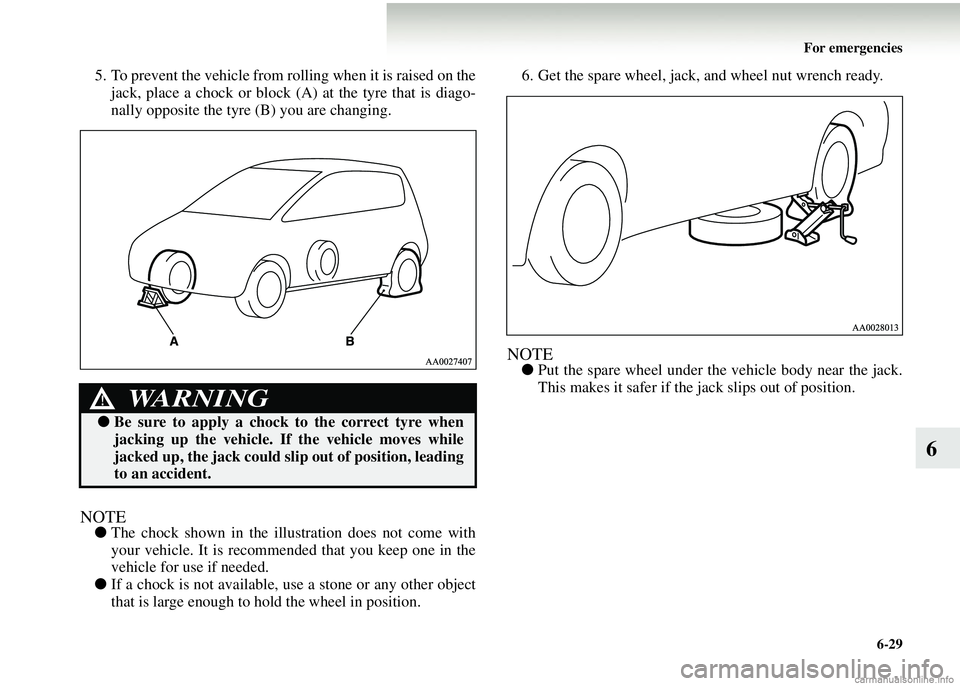
For emergencies6-29
6
5. To prevent the vehicle from rolling when it is raised on thejack, place a chock or block (A) at the tyre that is diago-
nally opposite the tyre (B) you are changing.
NOTE● The chock shown in the illustration does not come with
your vehicle. It is recommended that you keep one in the
vehicle for use if needed.
● If a chock is not available, use a stone or any other object
that is large enough to hold the wheel in position. 6. Get the spare wheel, jack, an
d wheel nut wrench ready.
NOTE●Put the spare wheel under the vehicle body near the jack.
This makes it safer if the jack slips out of position.
WARNING!
●Be sure to apply a chock to the correct tyre when
jacking up the vehicle. If the vehicle moves while
jacked up, the jack could sl ip out of position, leading
to an accident.
Page 321 of 450
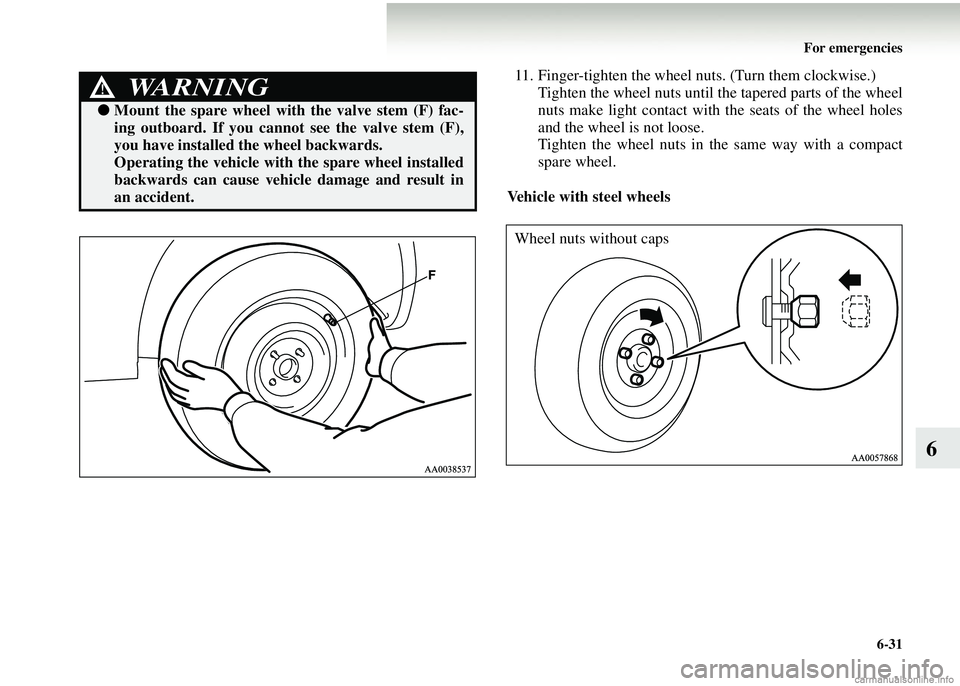
For emergencies6-31
6
11. Finger-tighten the wheel nut s. (Turn them clockwise.)
Tighten the wheel nuts until the tapered parts of the wheel
nuts make light contact with the seats of the wheel holes
and the wheel is not loose.
Tighten the wheel nuts in the same way with a compact
spare wheel.
Vehicle with steel wheels
WARNING!
● Mount the spare wheel with the valve stem (F) fac-
ing outboard. If you cannot see the valve stem (F),
you have installed the wheel backwards.
Operating the vehicle with the spare wheel installed
backwards can cause vehicle damage and result in
an accident.
Wheel nuts without caps
Page 330 of 450
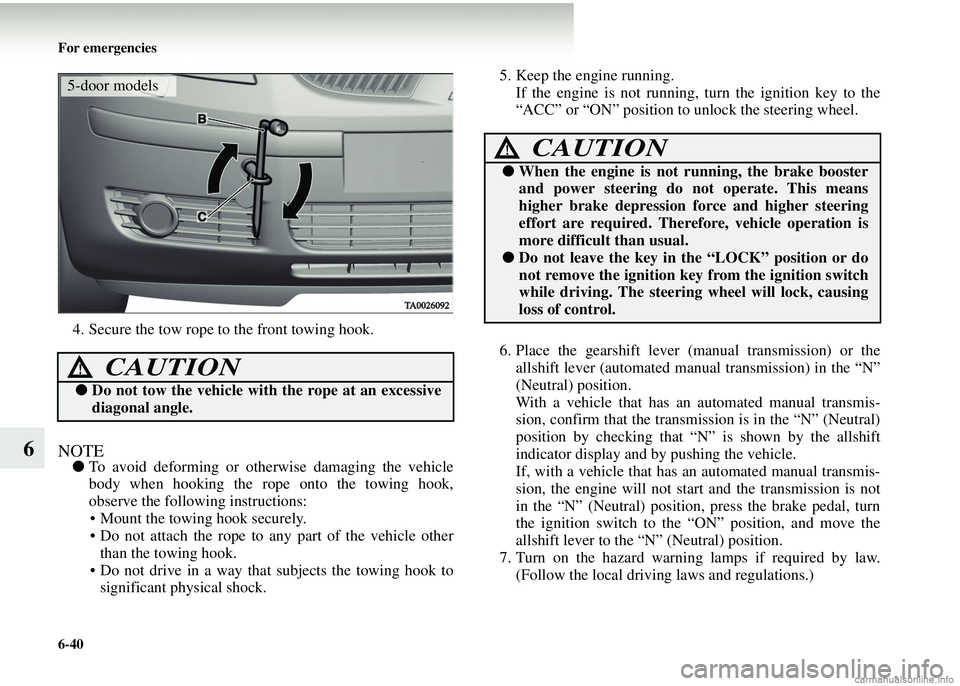
6-40 For emergencies
6
4. Secure the tow rope to the front towing hook.
NOTE●To avoid deforming or otherwise damaging the vehicle
body when hooking the rope onto the towing hook,
observe the following instructions:
• Mount the towing hook securely.
• Do not attach the rope to any part of the vehicle other
than the towing hook.
• Do not drive in a way that subjects the towing hook to significant physical shock. 5. Keep the engine running.
If the engine is not running, turn the ignition key to the
“ACC” or “ON” position to unlock the steering wheel.
6. Place the gearshift lever (m anual transmission) or the
allshift lever (automated manual transmission) in the “N”
(Neutral) position.
With a vehicle that has an automated manual transmis-
sion, confirm that the transmi ssion is in the “N” (Neutral)
position by checking that “N ” is shown by the allshift
indicator display and by pushing the vehicle.
If, with a vehicle that has an automated manual transmis-
sion, the engine will not start and the transmission is not
in the “N” (Neutral) position, press the brake pedal, turn
the ignition switch to the “ON” position, and move the
allshift lever to the “N” (Neutral) position.
7. Turn on the hazard warning lamps if required by law. (Follow the local driving laws and regulations.)
CAUTION!
● Do not tow the vehicle with the rope at an excessive
diagonal angle.
5-door models
CAUTION!
● When the engine is not running, the brake booster
and power steering do no t operate. This means
higher brake depression force and higher steering
effort are required. Therefore, vehicle operation is
more difficult than usual.
● Do not leave the key in the “LOCK” position or do
not remove the ignition key from the ignition switch
while driving. The steering wheel will lock, causing
loss of control.
Page 331 of 450

For emergencies6-41
6
8. During towing make sure that close contact is maintainedbetween the drivers of both ve hicles, and that the vehicles
travel at a low speed.
9. When towing is finished, remove the towing hook and store it in the specified location. (Refer to “Tools, jack and
tyre repair kit” on page 6-10.)
When installing the cover on the bumper, align the tab (D)
with the hole in the vehicle body and press the cover
securely into place.
WARNING!
● To prevent entry of exhaust gas from the towing
vehicle, set your air selection switch to the recircula-
tion position.
CAUTION!
●The person in the vehicle being towed must pay
attention to the brake lamps of the towing vehicle
and make sure the rope never becomes slack.
●Avoid sudden braking, sudden acceleration and
sharp turning; such opera tion could cause damage
to the towing hooks or the tow rope.
People in the vicinity coul d be injured as a result.
●When towing or being towed down a long slope, the
brakes may overheat reducing their effectiveness. In
this situation, have your vehicle transported by a
tow truck.
3-door models
5-door models
Page 332 of 450
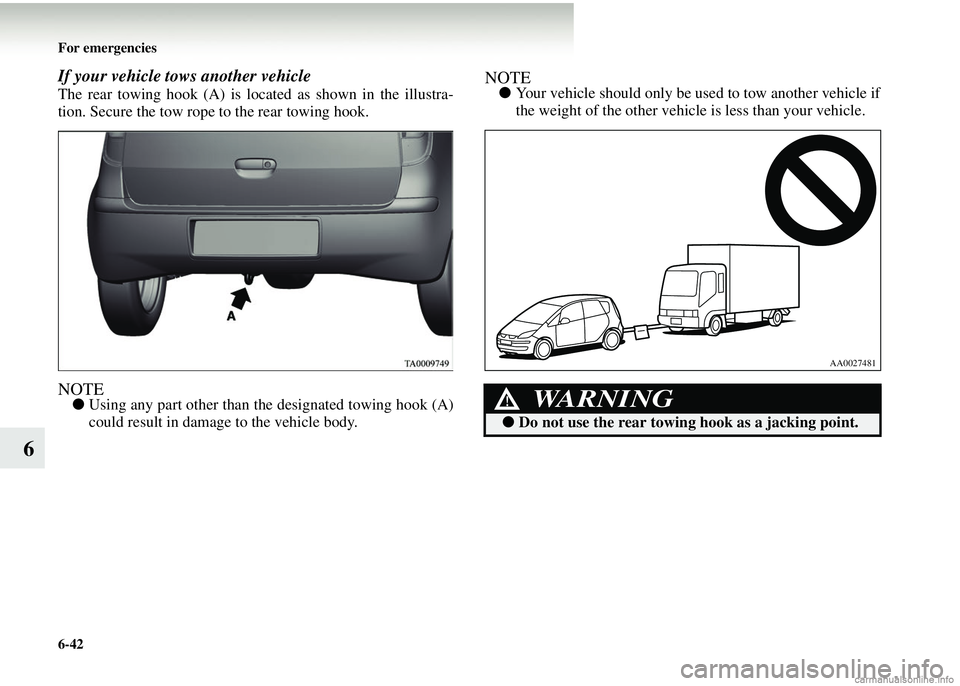
6-42 For emergencies
6
If your vehicle tows another vehicle
The rear towing hook (A) is located as shown in the illustra-
tion. Secure the tow rope to the rear towing hook.
NOTE●Using any part other than the designated towing hook (A)
could result in damage to the vehicle body.
NOTE●Your vehicle should only be used to tow another vehicle if
the weight of the other vehicle is less than your vehicle.
WARNING!
●Do not use the rear towing hook as a jacking point.
AA0027481
Page 333 of 450
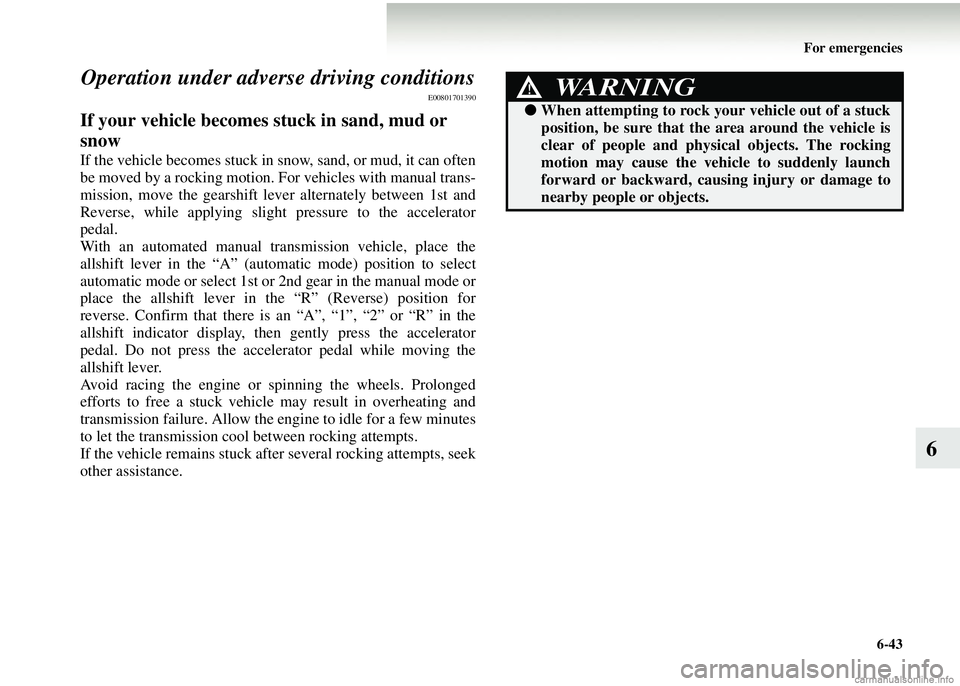
For emergencies6-43
6
Operation under adve
rse driving conditions
E00801701390
If your vehicle becomes stuck in sand, mud or
snow
If the vehicle becomes stuck in snow, sand, or mud, it can often
be moved by a rocking motion. Fo r vehicles with manual trans-
mission, move the gearshift leve r alternately between 1st and
Reverse, while applying slight pressure to the accelerator
pedal.
With an automated manual transmission vehicle, place the
allshift lever in the “A” (automatic mode) position to select
automatic mode or select 1st or 2nd gear in the manual mode or
place the allshift lever in th e “R” (Reverse) position for
reverse. Confirm that there is an “A”, “1”, “2” or “R” in the
allshift indicator display, then gently press the accelerator
pedal. Do not press the acceler ator pedal while moving the
allshift lever.
Avoid racing the engine or spinning the wheels. Prolonged
efforts to free a stuck vehicl e may result in overheating and
transmission failure. Allow the engine to idle for a few minutes
to let the transmission cool between rocking attempts.
If the vehicle remains stuck afte r several rocking attempts, seek
other assistance.
WARNING!
● When attempting to rock your vehicle out of a stuck
position, be sure that the area around the vehicle is
clear of people and physic al objects. The rocking
motion may cause the vehicle to suddenly launch
forward or backward, causing injury or damage to
nearby people or objects.
Page 344 of 450
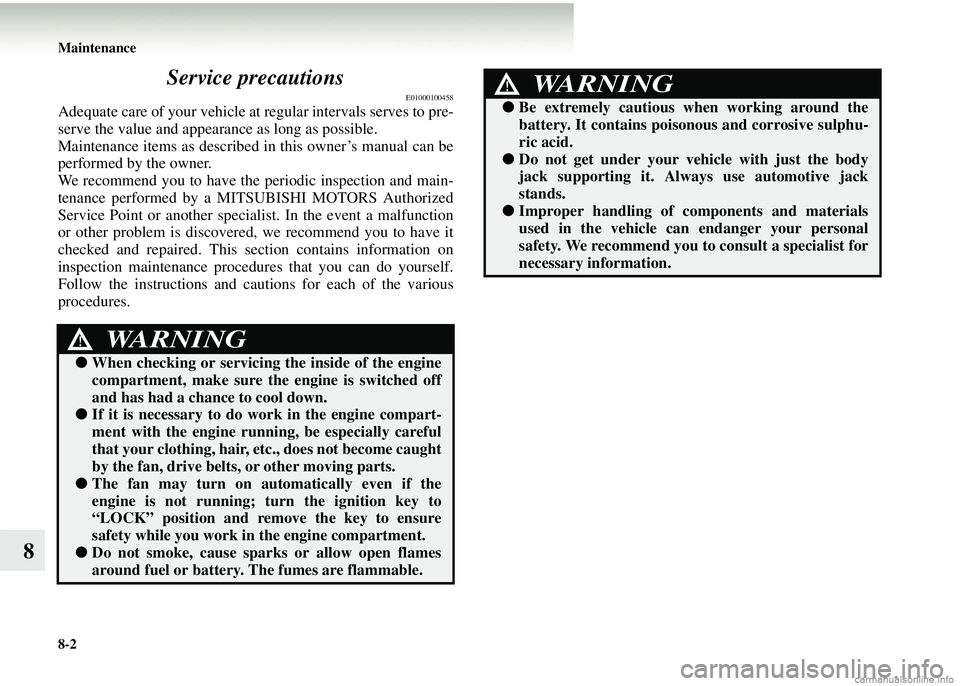
8-2 Maintenance
8Service precautions
E01000100458
Adequate care of your vehicle at
regular intervals serves to pre-
serve the value and appear ance as long as possible.
Maintenance items as described in this owner’s manual can be
performed by the owner.
We recommend you to have the periodic inspection and main-
tenance performed by a MITS UBISHI MOTORS Authorized
Service Point or another specialist. In the event a malfunction
or other problem is discovered, we recommend you to have it
checked and repaired. This section contains information on
inspection maintenance procedures that you can do yourself.
Follow the instructions and cautions for each of the various
procedures.
WARNING!
● When checking or servicing the inside of the engine
compartment, make sure th e engine is switched off
and has had a chan ce to cool down.
●If it is necessary to do work in the engine compart-
ment with the engine runni ng, be especially careful
that your clothing, hair, et c., does not become caught
by the fan, drive belts, or other moving parts.
● The fan may turn on automatically even if the
engine is not running; turn the ignition key to
“LOCK” position and remove the key to ensure
safety while you work in the engine compartment.
●Do not smoke, cause sparks or allow open flames
around fuel or battery. The fumes are flammable.
●Be extremely cautious wh en working around the
battery. It contains poison ous and corrosive sulphu-
ric acid.
● Do not get under your vehicle with just the body
jack supporting it. Always use automotive jack
stands.
●Improper handling of comp onents and materials
used in the vehicle can endanger your personal
safety. We recommend you to consult a specialist for
necessary information.
WARNING!
Page 345 of 450
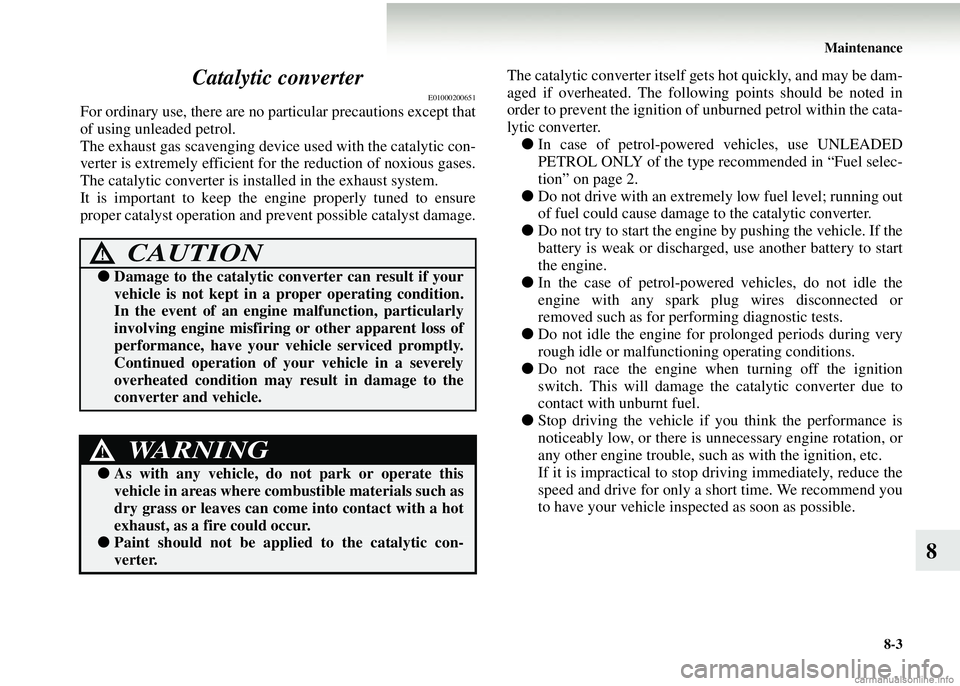
Maintenance8-3
8
Catalytic converter
E01000200651
For ordinary use, there are no
particular precautions except that
of using unleaded petrol.
The exhaust gas scavenging device used with the catalytic con-
verter is extremely ef ficient for the reduction of noxious gases.
The catalytic converter is inst alled in the exhaust system.
It is important to keep the engine properly tuned to ensure
proper catalyst operation and prevent po ssible catalyst damage. The catalytic converter itself gets hot quickly, and may be dam-
aged if overheated. The followi
ng points should be noted in
order to prevent the ignition of unburned petrol within the cata-
lytic converter. ● In case of petrol-powered vehicles, use UNLEADED
PETROL ONLY of the type recommended in “Fuel selec-
tion” on page 2.
● Do not drive with an extremely low fuel level; running out
of fuel could cause damage to the catalytic converter.
● Do not try to start the engine by pushing the vehicle. If the
battery is weak or discharged, use another battery to start
the engine.
● In the case of petrol-powered vehicles, do not idle the
engine with any spark plug wires disconnected or
removed such as for performing diagnostic tests.
● Do not idle the engine for prolonged periods during very
rough idle or malfunctioning operating conditions.
● Do not race the engine when turning off the ignition
switch. This will damage the catalytic converter due to
contact with unburnt fuel.
● Stop driving the vehicle if you think the performance is
noticeably low, or there is un necessary engine rotation, or
any other engine trouble, such as with the ignition, etc.
If it is impractical to stop driving immediately, reduce the
speed and drive for only a s hort time. We recommend you
to have your vehicle inspected as soon as possible.
CAUTION!
● Damage to the catalytic co nverter can result if your
vehicle is not kept in a proper operating condition.
In the event of an engine malfunction, particularly
involving engine misfiring or other apparent loss of
performance, have your vehicle serviced promptly.
Continued operation of your vehicle in a severely
overheated condition may re sult in damage to the
converter and vehicle.
WARNING!
● As with any vehicle, do not park or operate this
vehicle in areas where combustible materials such as
dry grass or leaves can come into contact with a hot
exhaust, as a fire could occur.
●Paint should not be applied to the catalytic con-
verter.
Page 354 of 450
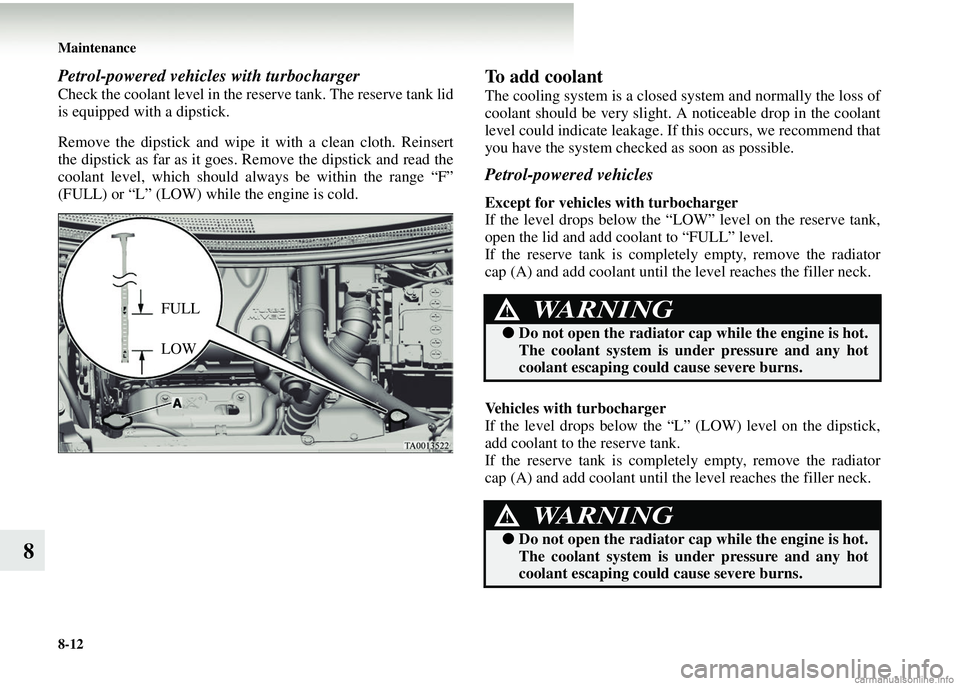
8-12 Maintenance
8
Petrol-powered vehicles with turbocharger
Check the coolant level in the reserve tank. The reserve tank lid
is equipped with a dipstick.
Remove the dipstick and wipe it with a clean cloth. Reinsert
the dipstick as far as it goes. Remove the dipstick and read the
coolant level, which should always be within the range “F”
(FULL) or “L” (LOW) while the engine is cold.
To add coolant
The cooling system is a closed system and normally the loss of
coolant should be very slight. A noticeable drop in the coolant
level could indicate leakage. If this occurs, we recommend that
you have the system checked as soon as possible.
Petrol-powered vehicles
Except for vehicles with turbocharger
If the level drops below the “LOW” level on the reserve tank,
open the lid and add coolant to “FULL” level.
If the reserve tank is completely empty, remove the radiator
cap (A) and add coolant until the level reaches the filler neck.
Vehicles with turbocharger
If the level drops below the “L” (LOW) level on the dipstick,
add coolant to the reserve tank.
If the reserve tank is completely empty, remove the radiator
cap (A) and add coolant until the level reaches the filler neck.
FULL
LOWWARNING!
● Do not open the radiator ca p while the engine is hot.
The coolant system is u nder pressure and any hot
coolant escaping coul d cause severe burns.
WARNING!
●Do not open the radiator ca p while the engine is hot.
The coolant system is u nder pressure and any hot
coolant escaping coul d cause severe burns.
Page 355 of 450
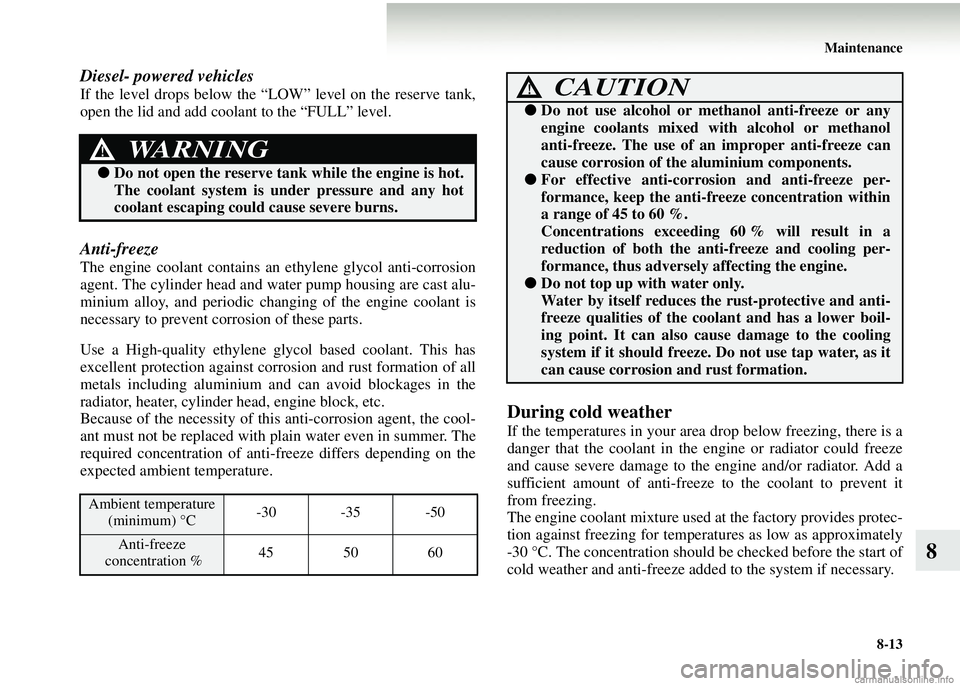
Maintenance8-13
8
Diesel- powered vehicles
If the level drops below the “LOW” level on the reserve tank,
open the lid and add coolant to the “FULL” level.
Anti-freeze
The engine coolant contains an ethylene glycol anti-corrosion
agent. The cylinder head and wa ter pump housing are cast alu-
minium alloy, and periodic changing of the engine coolant is
necessary to prevent corrosion of these parts.
Use a High-quality ethylene glycol based coolant. This has
excellent protection against corros ion and rust formation of all
metals including aluminium and can avoid blockages in the
radiator, heater, cylinder head, engine block, etc.
Because of the necessity of this anti-corrosion agent, the cool-
ant must not be replaced with plain water even in summer. The
required concentration of anti -freeze differs depending on the
expected ambient temperature.
During cold weather
If the temperatures in your ar ea drop below freezing, there is a
danger that the coolant in the engine or radiator could freeze
and cause severe damage to the engine and/or radiator. Add a
sufficient amount of anti-freeze to the coolant to prevent it
from freezing.
The engine coolant mixture used at the factory provides protec-
tion against freezing for temperat ures as low as approximately
-30 °C. The concentration should be checked before the start of
cold weather and anti-freeze added to the system if necessary.
WARNING!
●Do not open the reserve tank while the engine is hot.
The coolant system is under pressure and any hot
coolant escaping coul d cause severe burns.
Ambient temperature
(minimum) °C -30 -35 -50
Anti-freeze
concentration % 45 50 60
CAUTION!
●
Do not use alcohol or me thanol anti-freeze or any
engine coolants mixed with alcohol or methanol
anti-freeze. The use of an improper anti-freeze can
cause corrosion of the aluminium components.
● For effective anti-corro sion and anti-freeze per-
formance, keep the anti -freeze concentration within
a range of 45 to 60 %.
Concentrations exceeding 60 % will result in a
reduction of both the an ti-freeze and cooling per-
formance, thus adversel y affecting the engine.
●Do not top up with water only.
Water by itself reduces th e rust-protective and anti-
freeze qualities of the cool ant and has a lower boil-
ing point. It can also cause damage to the cooling
system if it should freeze. Do not use tap water, as it
can cause corrosion and rust formation.